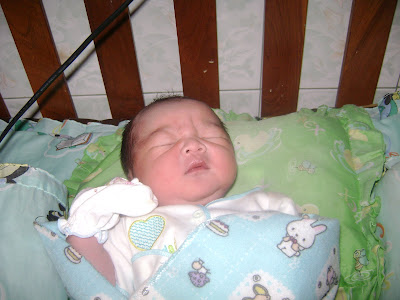In general contexts, a newborn is an infant who is within hours, days, or up to a few weeks from birth. In medical contexts, newborn or neonate (from Latin, neonatus, newborn) refers to an infant in the first 28 days of life (less than a month old). The term "newborn" includes premature infants, postmature infants and full term newborns.[1]
Appearance
When babies are first born, they're hardly the picture of infant beauty portrayed in advertising. Rather, a baby born at term can appear quite strange to many unprepared parents. The first time you see your newborn, he or she may be covered in a soapy white substance called vernix leaving the skin looking scaly. The skin may be loose and wrinkled, and your baby's skin color may be pale, even blue-gray, changing to a healthy pink after that important first cry. Your baby may be bald, or a have a full head of hair. There may be a fine downy hair covering a large part of his body. Your baby may have pink patches called stork bites on the forehead or neck, and the eyes could be puffy and swollen.[2]
Newborns have many variations in normal appearance - from color to the shape of the head. Some of these differences are just temporary, part of the physical adjustments a baby goes through. Others, such as birthmarks, may be permanent. Understanding the normal appearance of newborns can help you know that your baby is healthy. Some of the normal variations in newborns include the following:
* color
* moulding
* vernix
* lanugo
* milia
* stork bites
* mongolian spots
* erythema toxicum
* acne neonatorum "baby acne"
* strawberry hemangioma
* port wine stains
* newborn breast swelling
* swollen genitals/discharge[3]
Bonding
In most cases, infants seem to be in a state of quiet alertness during the first hour or so after delivery. It's a great time for you and your newborn to get acquainted and begin the bonding process. But don't despair if circumstances prevent you from meeting your infant right away. You'll have plenty of quality time together soon, and there's no scientific evidence that the delay will affect your infant's health, behavior, or relationship with you over the long run.
During the first several weeks, you'll notice that much of the time your baby will tend to keep his or her fists clenched, elbows bent, hips and knees flexed, and arms and legs held close to the front of his or her body. This position is similar to the fetal position during the last months of pregnancy. Infants who are born prematurely may display several differences in their posture, appearance, activity, and behavior compared with full-term newborns.[4]
Baby's Face
Eyes. Your baby's eyelids may be red and swollen from pressure during the delivery. In most hospitals, antibiotic drops are applied to the newborn's eyes. The drops may cause mild, temporary inflammation.
As your baby studies your face, you may notice one eye wanders or the two eyes don't move together smoothly. Unless one eye seems to be almost fixed in position (cross-eyed or wall-eyed), this wandering is normal and is corrected as the baby gains strength and coordination in the muscles that move the eyes.
Ears. The cartilage in the outer ear is very flexible in the newborn. If an ear looks folded, don't worry -- it will probably straighten out. If the problem continues, talk to your doctor.
Nose. At birth, the nose and mouth are often filled with mucus. After the delivery, your caregivers suction the baby's airways with a rubber syringe to clear them and help your baby breathe. Her own sneezing helps clear her nasal passages and is not necessarily the sign of a cold.
Mouth. An occasional baby already has one or more teeth at birth, which usually fall out. Your doctor may want to extract these teeth so your baby doesn't later choke on them.[5]
The newborn's senses
Newborns can feel all different sensations, but respond most enthusiastically to soft stroking, cuddling and caressing. Gentle rocking back and forth often calms a crying infant, as do massages and warm baths. Newborns may comfort themselves by sucking their thumb, or a pacifier. The need to suckle is instinctive (see suction in biology) and allows newborns to feed.
Newborn infants have unremarkable vision, being able to focus on objects only about 18 inches (45 cm) directly in front of their face. While this may not be much, it is all that is needed for the infant to look at the mother’s eyes or areola when breastfeeding. Depth perception does not develop until the infant is mobile. Generally, a newborn cries when wanting to feed. When a newborn is not sleeping, or feeding, or crying, he or she may spend a lot of time staring at random objects. Usually anything that is shiny, has sharp contrasting colors, or has complex patterns will catch an infant's eye. However, the newborn has a preference for looking at other human faces above all else.[6]

----
Notes:
[1] Wikipedia.org
[2] theparentreport.com
[3] lpch.org
[4] kidshealth.org
[5] health.howstuffworks.com
[6] wikipedia.org
========
About Me:
I am a 301 days / 10 months & 2 days old baby
A breastfed baby for 6 months and a formula-fed baby months after.

